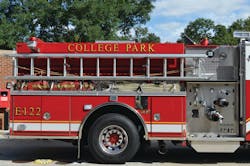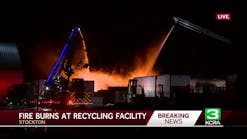The Apparatus Architect: Ground Ladders - Among Your Most Important Tools
Your fire department has just determined it is time to replace the 1995 100-foot quint rear-mount ladder with a new apparatus. The current vehicle is equipped with 158 feet of portable ground ladders including two 35 foot three section extension ladders and several 16 foot roof ladders.
While the apparatus committee is meeting with prospective bidders, one of the sales representatives mentions that National Fire Protection Association (NFPA) 1901, Standard for Automotive Fire Apparatus, now requires only 85 feet of ground ladders on quints and suggests that the group decide which is more important – a complement of ground ladders or a desired 500-gallon booster tank? How can you possibly ladder all four sides of a 2 ½-story private dwelling and the roof with 85 or even 115 feet? The reality will not support that. (In aerial ladder classes they conduct, the authors ask the participants how often they use portable ladders vs. the aerial device itself. The responses average out to be 7-1; for every one time that most fire departments use the aerial device, they use ground ladders seven times.)
When questioned on this issue, one of the senior members suggests that the committee review the first-due response area to evaluate structural conditions. While some on the apparatus committee thought this to be a waste of time, others suggested that the 500-gallon booster tank is a nice feature, but not critical in the department’s operations. After a few weeks spent touring the response area and measuring some building heights, a number of concerns came to light. Since the 1995 quint was placed into service, several townhouse complexes were built that are three stories in height from the A side, but due to terrain are four to five stories high on the C side. In addition, previously undeveloped farmland was turned into a residential subdivision containing 5,000- to 6,000-square-foot “McMansions” with limited access for aerial ladder trucks.
After considering the building and demographic changes to the response area, the truck committee decided to reevaluate the importance of ground ladders on the new apparatus. The NFPA 1901 requirements for the ground ladder complements on a quint or non-quint ladder have remained at 85 and 115 feet for a number of years. These suggested ladder complements are a minimum and must ultimately be determined by fire departments based on the buildings in their response districts, apparatus assignments, operating guidelines and fireground experiences.
Standard complement
The standard ground ladder complement on most pumpers is a 14-foot roof ladder, 24-foot extension ladder together with a 10-foot folding ladder. In addition to the traditional mounting on the right side of the apparatus, ground ladders can be carried on a hydraulic rack or enclosed in the body or through the water tank. The hydraulic rack works well when there is no overall travel height concern and permits longer ladders to be carried. Departments that wish to have the ladders fully enclosed within the body must sacrifice compartment space or contend with a three-section extension ladder if sufficient space is not available to accommodate a two-section ladder.
Aerial ladders and towers are commonly designed with a fire pump, booster tank and a hosebed for supply line. The hosebed may be located ahead of the aerial turntable or on the side of the body over the lower compartments. In either case, the quantity of ground ladders you wish to carry on the apparatus is determined by the available space under the turntable and outside of the body based on the water tank size, depth of the body compartments, amount of supply line carried and the location of other components such as the hydraulic oil reservoir and waterway piping. There is only so much space; if you fill it up with a pump, tank and hose, you can not fill it up with portable ladders.
One aluminum ground ladder company’s catalog lists a two-section, 35-foot extension ladder as having a closed length of 20 feet, one inch with a weight of 139 pounds. A three-section version of the same ladder is 15 feet, eight inches long and weighs 170 pounds. A truss-style version of the two-section, 35-foot ladder has a slightly higher banking thickness, but is only two pounds heavier than a solid-beam, pumper-style extension ladder. The ground ladder banking on any aerial device can be determined in conjunction with the apparatus manufacturer’s body engineering group, which can provide suggestions to enable your apparatus committee to maximize the available space to carry portable ladders.
Meeting your needs
The College Park, MD, Fire Department operates as Station 812 in Prince George’s County with two engines, a rear-mount ladder, a foam unit, a hazardous materials support unit, two ambulances and a medic unit. Due to the building and structural conditions on the University of Maryland campus and the surrounding response area, the department has outfitted its engines and a county-provided ladder truck with a diverse complement of ground ladders.
Prince George’s County recently placed into service two Pierce Arrow XT 105-foot rear-mount ladders that carry a total of 266 feet of ground ladders, including a 45-foot bangor ladder (an extension ladder controlled by poles), two 35-foot extension ladders together with two 16-foot roof ladders and a 28-foot extension ladder carried on the right side of the apparatus. The ground ladder banking is clearly marked to indicate the length of each ladder. A simple solution may be to label the inside portion of the ladder guard with reflective numbers in addition to marking the butt spurs on the ladders with the appropriate length of each ladder.
Ground ladder storage areas aerial apparatus are largely dependent on the packaging of other chassis and body components. The banking arrangement of on-beam or flat positions may also be influenced based on the maximum travel height of the apparatus, so when specifying a new apparatus it is a good idea to confirm the principal dimensions of the apparatus bays, including ramp angles and other height restrictions in the response area.
Tractor-drawn ladders have a distinct advantage of having almost unlimited space to carry portable ladders both inside of the trailer and on each side of the body compartments. Where there is a requirement to carry a number of longer roof and wall ladders in addition to multiple two-section extension ladders, a tractor-drawn aerial can easily accommodate more than 300 feet of portable ladders with room to spare.
When designing any new aerial device, careful consideration must be given to determining the appropriate number and configuration of portable ground ladders. As the old fire service proverb goes: “You can stretch a hose, but you cannot stretch a ladder.”
While operating on the fire ground the proper placement of ground ladders is of vital importance for the safety of our personnel as well as any potential victims within the building. No other agency responding to our incidents is carrying portable ladders, so make sure you have pre-planned your first-due area to ensure that your rigs are carrying the correct complements of ground ladders.
TOM SHAND, a Firehouse® contributing editor, is a 36-year veteran of the fire service and works with Michael Wilbur at Emergency Vehicle Response, consulting on a variety of fire apparatus and fire department master-planning issues. MICHAEL WILBUR, a Firehouse® contributing editor, is a lieutenant in the New York City Fire Department, assigned to Ladder Company 27 in the Bronx, and has served on the FDNY Apparatus Purchasing Committee. He consults on a variety of apparatus-related issues around the country. For further information, access his website at www.emergencyvehicleresponse.com.







